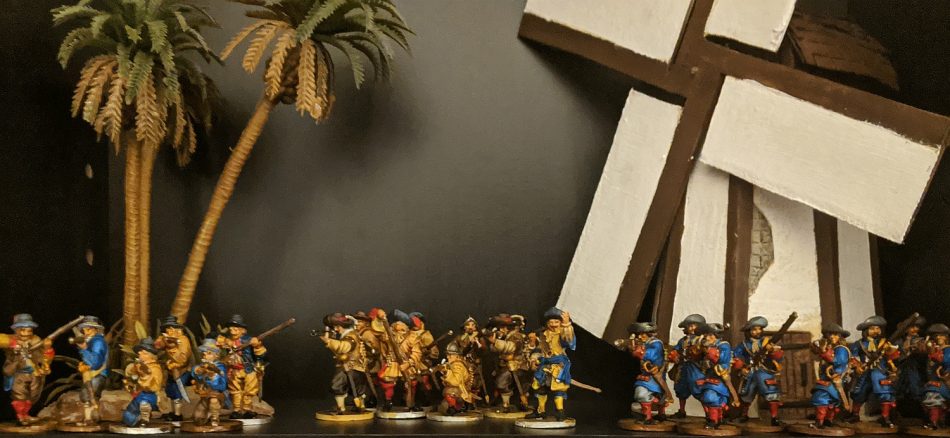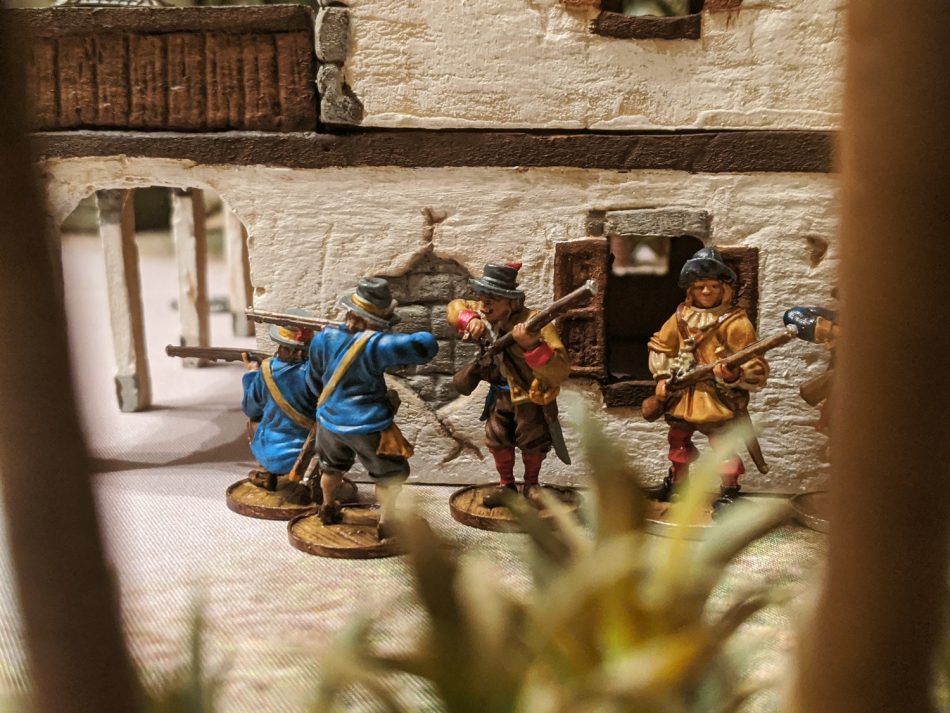Blood & Plunder Force Building: pt. 1
By Tyler Stone
Now that we’ve been out of lockdown for a while and things are getting back to normal, I’ve been able to start getting more games in. I have noticed many new players seem to have shown up during the quarantine. Some of you might have jumped in right as everything started to shut down. Some might have decided to get up to speed before the finalized. Whatever the case may be, this article is for you! Today, let’s talk about Force Building for
Before we start, I want to make one thing clear – I am not going to be showing you how to build “the ultimate net-list.” I played GW games and Magic: the Gathering for a long time. I’ve been there, done that, and got the sweaty tee-shirt to prove it. This article is just a “how to” for putting your own list together, but I’ll pepper in a few Tactical Tips along the way. I’ll also be using the , if you want to follow along.

1. Picking a Faction
The first step to building a force is to choose which Faction you’d like to represent on the table. There are 6 available factions at the time of writing. Don’t worry much about “playstyle” right now – every Faction has options to be proficient in most styles. Choose a faction that speaks to you, whether it be the look of the models, or some family connection. If you still need a summary though, here are brief descriptions for each of the major forces –
- Dutch: Strict, seagoing fighters
- English: Dependable, well-rounded buccaneers
- French: Expert marksmen, ancient rivals of the English
- Natives: Ambushers, marking their arrival with a rain of arrows
- Spanish: Ruthless underdogs of the New World
- Unaligned: Pirates and lesser nations, varied and manifold
Tactical Tip!
There are 6 factions, but you’ll notice that Firelock sells 8 different “starters.” The two extra options are ‘European Militia,’ and ‘Pirates & Privateers. Yet, the term “starter” is a bit misleading. These two boxes are best used for expanding an existing force. This is because both boxes include specialized units, such as artillery and weapon upgrades.
2. Choosing a Subfaction
Once you’ve chosen a Nationality, you’re presented with a list of Subfactions, and a list of Commanders. The list of Commanders is long, but choosing a Subfaction narrows it significantly. I recommend picking a Subfaction first, unless you want a specific character.
Subfactions will provide you with flavorful special rules which apply to your force. Some also give extra options, where you can choose to further refine your army. You are not required to choose one of these options. Your subfaction will also show any modifiers to the roll for determining Attacker. Finally, your choice of subfaction dictates which Commanders and Units you have available.
You can see that I’ve chosen Dutch, with the Caribbean Militia subfaction3. Choosing a Commander
Once you’ve narrowed down the list by choosing a subfaction, the Force Builder will require you to choose a Commander. Every subfaction has the option of a 0-point, 15-point, and 25-point “generic” Commander, as well as Named Characters. The number of Special Rules, Command Points, and the radius at which you can use those Command Points will increase with more expensive commanders. Some named characters also have the special rule ‘Unconventional Force.’ This rule modifies the selection of units you have available in the next step.
One bugaboo with the Force Builder is that once you have chosen a Captain, you cannot undo the selection without removing all of the units chosen for your force. For this reason, I usually pick the 0 point Commander unless I know that I’m choosing one with ‘Unconventional Force’. Then, I can always see where my list finishes out, and upgrade my commander from there.
For flavor, I’ve taken David Nassy as my commander. He has the Unorthodox Force rule, which will let me field Jewish Militia as CoreTactical Tip!
You want to balance the number of Command Points, to the number of units that you’re going to be fielding. This makes the Force Builder frustrating, since you won’t know how many units you’ve got until you’re finished. Don’t overlook the lower quality Commanders right away though. Even though they only offer a single Command Point, you can always pick up the ‘Officer’ Fighting Man and add another Command Point for 8 points. Likewise, a 2 point Musician gets you ‘Inspiring’. We’ll discuss Fighting Men in more detail later.
Step 4. Choosing Units
With your Subfaction and Commander picked out, the Force Builder will display two columns of units to build your force from. On the left side are your Core units, and Support units on the right. You must include 2 Core Units for each Support Unit in your force. The Force Builder will put up an error message if you break this rule. If you’re following along in the rulebook remember that it’s 2:1.
The other major hang-up is knowing how many models you can include in a unit. If you set the Points Limit on the Force Builder to the size of game you plan on playing, it will automatically set the minimum number of models for a unit, and stop you from exceeding the maximum. For those playing at home, the formula is simple:
Minimum Unit Size is 2, and increases by 1 for every 100-points.
(0-99 is 2, 100-199 is 3, 200-299 is 4, etc)
Maximum Unit Size is 4, and increases by 4 for every 100-points.
(0-99 is 4, 100-199 is 8, 200-299 is 12, etc)
Tactics Tip!
It’s normal to vary the size of your units. Bigger units make efficient use of Command Points, and cause more damage to enemy forces before they have a chance to strike back. The downside is that a few bad Resolve rolls can have a huge part of your force running for cover. Smaller units spread Fatigue, for you and for your enemy. They’re also better for specialized tasks.Pay attention to your Strike Points as well. You take a Strike for every quarter of your force that you’ve lost, and you round the number of models down. For example, whether you have 16 or 19 models, you gain a Strike Point after 4 casualties. If you have 20 models, you gain a Strike Point after 5. Sometimes it can be worth replacing an expensive model with several cheaper ones to cross a Strike threshold.
A final point of confusion comes from Unit Upgrades. You can choose to have different units carrying different equipment. For example, one unit of Marin might exchange their pistols for Muskets, one might keep add a Blunderbuss, and a third might discard their pistols. This is all fine. However, all units of a type must have the same experience rating. If you upgrade the first unit of Marins to ‘Veteran,’ then you must upgrade the other 2 units to Veteran as well! The Force Builder will do this automatically, so don’t be caught off guard!
A unit of Jewish Militia. Although they have exchanged Drilled, other units may still keep the Drilled rule. I will not be upgrading them to Veteran though.Tactics Tip!
Be aware of the ‘Economy of Scale’ on some upgrades. Sailors can make excellent musketeers – the entire unit can usually take muskets for +4 points. If you have 4 sailors, that’s +1 point per man, but if you have 8 men, it’s half that per figure.Vary your experience levels and think about your activation cards. If you have a unit with a rule like ‘Quick’ that wants you to play Spades, many of your Spades will be going to them. Inexperienced units are a great catch-all for your slow cards, like Clubs. Try to have a good mix of experience levels or suit-specific skills, so that you can make the most of any hands you draw.
Step 5. Choose Force Upgrades
The final step to your force, is to buy any extra upgrades you might want. The most common upgrade, is buying and outfitting a ship, but I will discuss that in much more detail in part 2.
On land, you might choose to field Defenses, such as a tower or . Defenses can be helpful not only for the cover they provide, but also because if only one player brings Defenses, that player is automatically the Defender in any scenario.
You can also include ‘Hostages and Advisors’, and ‘Fighting Men.’ These two types of “lesser characters” have confused the community for a long time.
include the Captured Merchant, Spy, Ship’s Pilot, Local Guide, and Spiritual Leader. They must be attached to your Commander’s unit, and they count as their own model. Firelock sells a pack of miniatures that includes all but the Spiritual Leader. These models do not carry weapons, or participate in combat.
‘Fighting Men’ are taken as an upgrade to a model already in the unit. For example, if you have 5 SeaDogs, you can upgrade one of them to a ‘Son of Neptune’ for +3 points. Unless specified, this model keeps any weapons that it already had, and fights like a member of its unit. Any unit can include a Fighting Man, but they follow the limitation of only a single character per unit. The only exception are the Musician and Standard Bearer, who must be attached to your Commander’s unit.
Tactics Tip!
Fighting Men are an excellent way to add Command Points to your force. The ‘Grizzled Veteran’ and ‘Son of Neptune’ can both give Rally orders to any unit within 3 inches. The ‘Master Gunner’ can reload artillery. The ‘Officer’ is a real value, being essentially a “mini-Commander” you can attach to any unit. This makes them great inclusions for any part of your force which might operate away from your main force; Cavalry, for example.
You can also include artillery in your force. On land you can choose to either attach your artillery to a structure (if you’ve taken one, like the tower) or to a Field Carriage. The points for each are listed on the Force Builder. You can only include artillery on a field carriage if you have a unit with the ‘Field Gun’ special rule. That unit must also begin the game attached to the artillery piece. Artillery taken as part of a structure must remain with the structure, but does not need to start the game with an assigned crew.
The Grizzled Veteran that I will be adding to a unit of SoldatenAnd you’re done!
Now you have a force, ready for the battlefield! If you haven’t collected your miniatures already, then you can click the “buy force” link, and it will add all the necessary models to your shopping cart on Firelock’s website. You may still want to go in and check that everything is correct, and even diversify some of your units. Firelock’s rules are that a model needs to only be accurate for what it is armed with, and be easily identified. For instance, most people consider that a Sailor is a Sailor, be he a Marin, SeaDog, or Zeelieden. The generic ‘European’ models can also be added to any force, with Sailor Musketeers rounding out any musket-armed unit.

All that’s left is to if you haven’t already, and get to playing! The ‘tactics tips’ from this article are basic considerations for any game, land or sea. My next article will focus more on Sea Battles, including the rules for outfitting ships, and tactics that are handy when fighting your battles across the bounding waves.
As always, feel free to ask questions below, and I’ll try to be sure that I answer them. The on Facebook is also a great source for information and answers to your rules questions. Stay tuned for Part 2, Sea Battles!
